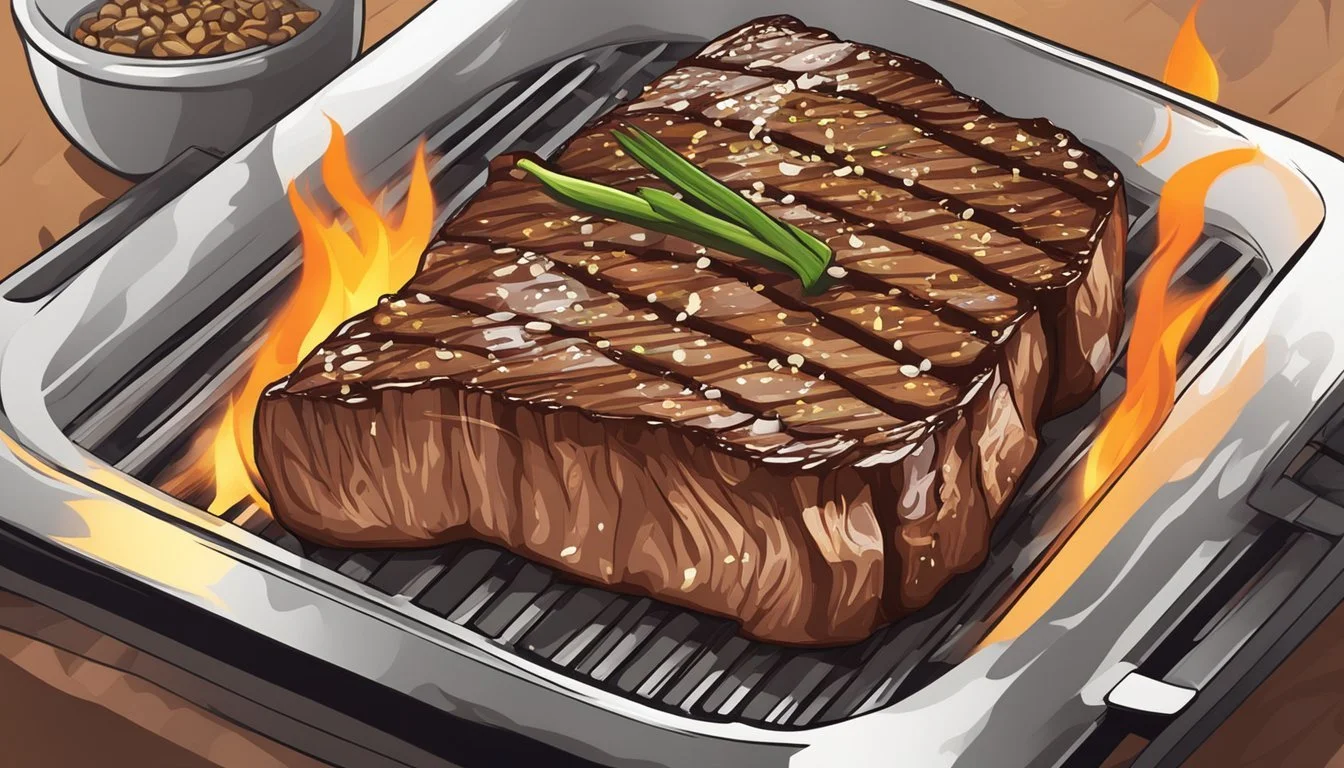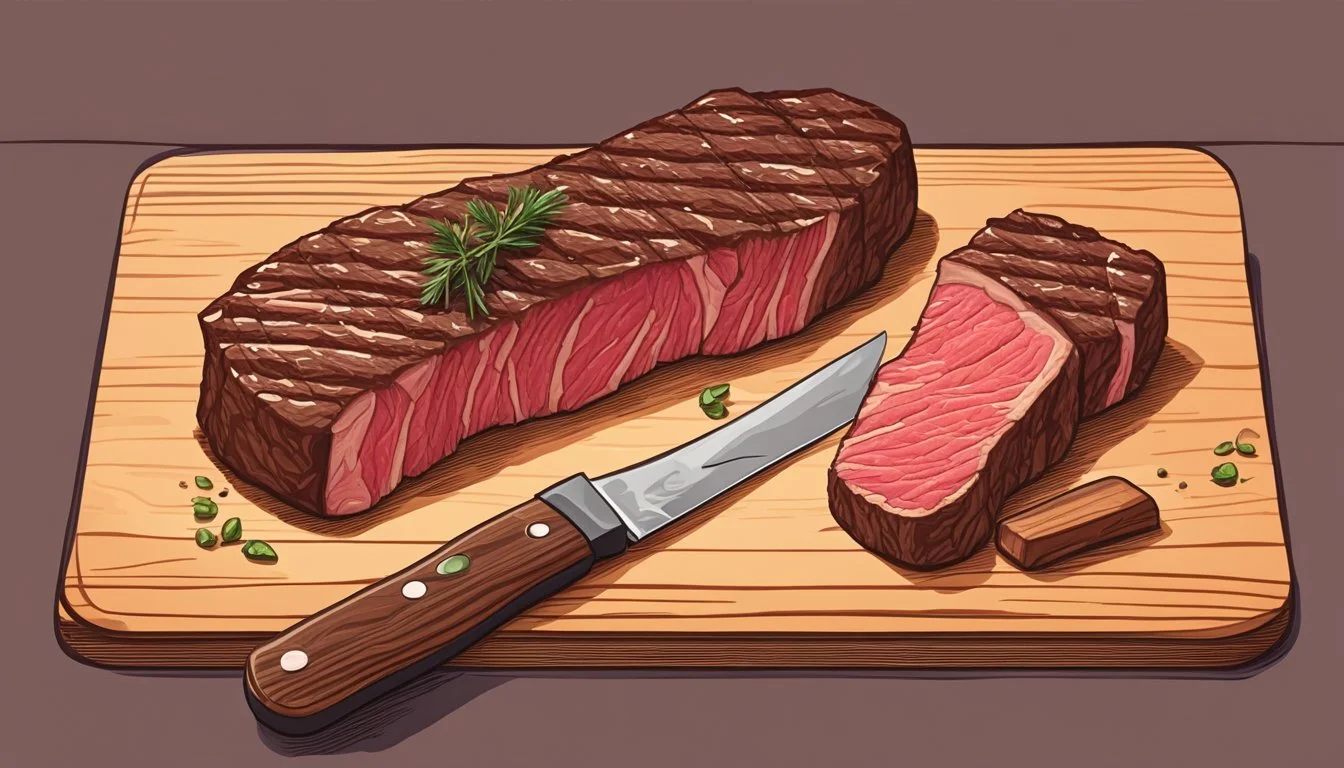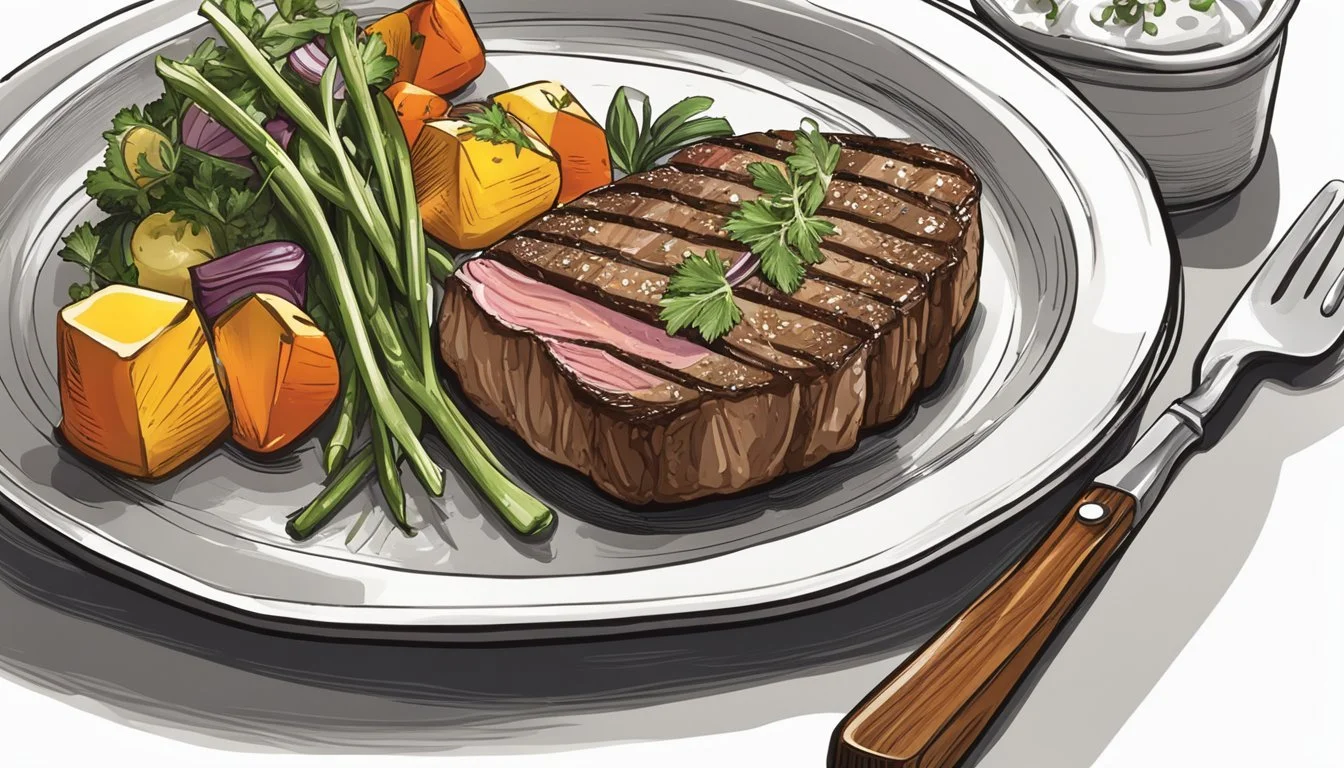Mastering the Perfect New York Strip
Steakhouse Quality at Home
New York strip steak stands out as a prized cut of beef, known for its rich flavor and tender texture. This popular steak comes from the short loin of the cow and offers a perfect balance of marbling and lean meat.
To cook the perfect New York strip, start by bringing the steak to room temperature and seasoning it generously with salt and pepper. This simple preparation allows the natural flavors of the beef to shine through. Preheat a cast iron skillet or grill pan over high heat until it's smoking hot.
Sear the steak for 2-3 minutes on each side to develop a flavorful crust, then finish cooking it to your desired doneness. For medium-rare, aim for an internal temperature of 125°F (52°C). Let the steak rest for 5-10 minutes before slicing to allow the juices to redistribute, ensuring a juicy and flavorful result.
Understanding New York Strip Steak
New York strip steak is a popular and flavorful cut of beef prized for its tenderness and rich taste. This cut comes from the short loin of the cow and offers a balance of lean meat and marbling that contributes to its desirable texture and flavor profile.
Identifying Quality New York Strip
A high-quality New York strip steak has a bright red color with white marbling throughout. The meat should be firm to the touch and have a slight sheen. Look for steaks that are 1 to 1.5 inches thick, as this allows for optimal cooking and flavor development.
The cut should have a clear strip of fat along one edge. This fat renders during cooking, adding flavor and juiciness to the meat. Avoid steaks with excessive gristle or large pockets of fat within the meat itself.
Quality New York strips often have USDA grades of Choice or Prime, indicating higher levels of marbling and tenderness.
The Importance of Marbling
Marbling refers to the white flecks of intramuscular fat distributed throughout the meat. This fat is crucial for flavor and tenderness in New York strip steaks.
As the steak cooks, marbling melts, creating pockets of juiciness and enhancing the beef's natural flavor. More marbling generally results in a more tender and flavorful steak.
USDA Prime grade New York strips have the highest levels of marbling, followed by Choice and then Select grades. While Prime offers superior taste and texture, Choice grade steaks can still provide excellent eating experiences at a more affordable price point.
Comparison to Other Cuts
New York strip steak is often compared to other popular cuts like ribeye and tenderloin. Here's how it stacks up:
Tenderness: More tender than ribeye, but slightly less tender than tenderloin
Flavor: Bolder beef flavor than tenderloin, comparable to ribeye
Fat content: Less fatty than ribeye, more fat than tenderloin
Texture: Firmer texture than ribeye or tenderloin
New York strip is sometimes called Kansas City strip steak, particularly in the Midwest. It offers a balance of tenderness and flavor that many steak enthusiasts prefer over other cuts.
Preparing for Cooking
Proper preparation is key to achieving a perfectly cooked New York strip steak. The following steps will ensure your steak is primed for cooking and ready to deliver maximum flavor.
Achieving Room Temperature
Remove the New York strip steak from the refrigerator 30-60 minutes before cooking. This allows the meat to reach room temperature, promoting even cooking throughout.
Place the steak on a plate or cutting board. Cover it loosely with plastic wrap to prevent contamination.
Room temperature steak cooks more evenly, resulting in a better sear and more consistent doneness from edge to center.
Seasoning the Steak
Pat the steak dry with paper towels to remove excess moisture. This step is crucial for achieving a good sear.
Apply a generous amount of kosher salt and freshly ground black pepper to all sides of the steak. For added flavor, consider using garlic powder, onion powder, or dried herbs like rosemary and thyme.
Some cooks prefer to season just before cooking, while others season an hour in advance to allow the flavors to penetrate the meat.
Preheating the Cookware
Choose your cooking method: skillet, grill, or oven. For stovetop cooking, a cast iron skillet is ideal due to its heat retention properties.
Preheat the skillet over medium-high heat for 5-10 minutes. Add a high smoke point oil like vegetable or grapeseed oil when the pan is hot.
For grilling, preheat the grill to high heat (450-500°F) for 10-15 minutes. Clean and oil the grates to prevent sticking.
If using the oven, place a cast iron skillet inside and preheat to 400°F. This method combines stovetop searing with oven finishing for precise temperature control.
Cooking Methods
New York strip steaks can be prepared using several techniques to achieve optimal flavor and texture. Each method offers unique benefits for creating a delicious steak experience.
Pan Searing Technique
Pan searing is a quick and effective way to cook New York strip steaks. Heat a cast iron skillet over high heat until smoking. Add oil with a high smoke point, such as vegetable or grapeseed oil. Place the steak in the hot pan and cook for 3-4 minutes on each side for medium-rare.
Flip the steak every 30 seconds to ensure even cooking. This frequent flipping helps develop a nice crust while maintaining a juicy interior. For added flavor, add butter, garlic, and herbs to the pan during the last minute of cooking. Baste the steak with the melted butter mixture.
Let the steak rest for 5-10 minutes before slicing to allow the juices to redistribute.
Grilling to Perfection
Grilling imparts a smoky flavor and creates appetizing grill marks on New York strip steaks. Preheat the grill to high heat, around 450-500°F. Clean and oil the grates to prevent sticking.
Place the steak on the hot grill and cook for 4-5 minutes per side for medium-rare. Use tongs to flip the steak, avoiding piercing the meat with a fork. This helps retain the juices.
For crosshatch grill marks, rotate the steak 45 degrees halfway through cooking on each side. Remove the steak when it reaches an internal temperature of 130-135°F for medium-rare.
Oven Roasting
Oven roasting is ideal for thicker New York strip steaks. Preheat the oven to 400°F. Heat an oven-safe skillet over high heat on the stovetop. Sear the steak for 2-3 minutes per side to develop a crust.
Transfer the skillet with the steak to the preheated oven. Cook for 6-8 minutes for medium-rare, or until the desired internal temperature is reached. Use a meat thermometer to check doneness.
This method combines the benefits of pan searing and even oven cooking, resulting in a perfectly cooked steak throughout.
Low and Slow Approach
The low and slow method produces a tender, evenly cooked New York strip steak. Preheat the oven to 250°F. Place the steak on a wire rack set over a baking sheet. Cook in the oven until the internal temperature reaches 115°F, about 25-30 minutes.
Finish the steak by searing in a hot skillet for 1-2 minutes per side. This reverse sear technique allows for precise temperature control and results in a consistent doneness from edge to edge.
Let the steak rest for 5 minutes before serving. This method works well for thicker cuts and those who prefer their steak cooked to higher levels of doneness.
Achieving the Perfect Doneness
Mastering the ideal doneness for a New York strip steak requires precision and attention to detail. The right techniques ensure a juicy interior and flavorful crust while achieving your preferred level of doneness.
Temperature Tips
Use a reliable meat thermometer to gauge internal temperature accurately. For medium-rare, aim for 130-135°F (54-57°C). Medium doneness reaches 140-145°F (60-63°C).
Remove the steak from heat 5°F below target temperature. It will continue cooking during rest time.
Place the thermometer in the thickest part of the steak, avoiding fat or bone. For thinner cuts, insert it sideways.
Allow the steak to rest 5-10 minutes after cooking. This redistributes juices, ensuring a more evenly cooked and juicier result.
Visual and Tactile Cues
Color changes indicate doneness. A rare steak is red in the center, medium-rare is pink, and medium has a light pink center.
Press the steak gently with tongs or your finger. Rare feels soft, medium-rare offers slight resistance, and medium feels firmer.
A properly seared crust forms a dark brown exterior. This contributes to flavor and texture while sealing in juices.
For consistent results, combine temperature readings with visual and tactile checks. This multi-pronged approach helps achieve the perfect doneness every time.
Resting and Slicing
Proper resting and slicing techniques are crucial for maximizing the flavor and tenderness of a New York strip steak. These steps ensure the juices redistribute throughout the meat and maintain its succulence.
The Importance of Rest
After cooking, allow the steak to rest for 5-10 minutes. This period lets the juices redistribute, resulting in a more flavorful and juicy eating experience.
Place the steak on a cutting board or warm plate. Loosely cover it with foil to retain heat without trapping moisture.
The internal temperature will continue to rise slightly during resting, a process known as carryover cooking. This contributes to the final doneness of the steak.
Resting also allows the muscle fibers to relax, making the meat more tender when cut. Skipping this step can lead to a loss of flavorful juices when slicing.
Carving Techniques
Proper slicing is essential for optimal tenderness. Always cut against the grain of the meat to shorten muscle fibers and reduce chewiness.
Identify the direction of the muscle fibers running through the steak. Cut perpendicular to these lines for the most tender bite.
Use a sharp knife to make clean cuts. A dull blade can tear the meat, affecting texture and presentation.
Aim for slices about 1/4 to 1/2 inch thick. This thickness preserves the steak's juiciness while providing satisfying bites.
For best results, slice only what you plan to eat immediately. Leave the rest intact to maintain moisture and temperature for second servings.
Finishing Touches & Serving
The final steps can elevate a New York strip steak from good to exceptional. Carefully chosen accompaniments and flavorful additions enhance the overall dining experience.
Compound Butter and Sauces
Compound butter adds richness and complexity to a perfectly cooked New York strip. Mix softened butter with herbs like thyme, rosemary, or chives. Garlic, shallots, or blue cheese can be incorporated for extra flavor. Place a pat of compound butter on the hot steak to melt and infuse it with delicious taste.
For those who prefer sauces, a classic béarnaise or peppercorn sauce pairs well with New York strip. A simple red wine reduction can also complement the meat's natural flavors. Chimichurri, a zesty Argentinian sauce made with parsley, garlic, and vinegar, offers a fresh contrast to the steak's richness.
Selecting Suitable Side Dishes
Potatoes are a classic pairing for New York strip steak. Crispy roasted potatoes, creamy mashed potatoes, or golden french fries all work well. For a lighter option, consider a mixed green salad with a tangy vinaigrette.
Grilled or roasted vegetables provide a nutritious balance to the meal. Asparagus, Brussels sprouts, or bell peppers are excellent choices. Sautéed mushrooms complement the steak's umami flavor. A simple steamed broccoli or green beans can add color and freshness to the plate.
For a complete meal, consider serving the steak with both a starch and a vegetable side. This creates a well-rounded dish that satisfies various tastes and nutritional needs.
Recipe Variations and Ideas
New York strip steak lends itself to a variety of preparation methods and flavor profiles. Experimenting with different recipes and seasonings can elevate this cut to new heights.
Classic and Contemporary Recipes
Pan-searing is a popular technique for cooking New York strip steak. Heat a cast-iron skillet over medium-high heat, add oil, and cook the steak for 3-4 minutes per side for medium-rare. For a steakhouse-style finish, transfer the skillet to a preheated 400°F oven for 5-7 minutes.
Grilling offers another classic approach. Preheat the grill to high heat. Place the steak on the grates at a 45-degree angle and cook for 2-3 minutes. Rotate 90 degrees and cook for another 2-3 minutes. Flip and repeat for the other side.
For a contemporary twist, try a reverse sear. Start by cooking the steak in a 250°F oven until it reaches 115°F internally. Then sear it in a hot skillet for 1-2 minutes per side to develop a crust.
Marinades and Spice Rubs
A simple yet effective marinade combines olive oil, minced garlic, fresh thyme, and black pepper. Marinate the steak for 2-4 hours before cooking.
For a bold flavor profile, create a spice rub with:
2 tbsp paprika
1 tbsp garlic powder
1 tbsp onion powder
1 tsp black pepper
1 tsp salt
Apply the rub generously to both sides of the steak 30 minutes before cooking. This allows the flavors to penetrate the meat.
A coffee rub offers a unique taste experience. Mix ground coffee with brown sugar, chili powder, and salt. Pat the mixture onto the steak and let it sit for an hour before grilling.
For special occasions, try a herb butter topping. Mix softened butter with chopped fresh herbs like rosemary, thyme, and parsley. Place a dollop on the cooked steak just before serving.
Storing and Reheating
Proper storage and reheating techniques are crucial for maintaining the quality of leftover New York strip steak. These methods help preserve its lean, tender, and juicy characteristics.
Proper Storage Techniques
Store cooked New York strip steak in an airtight container or wrapped tightly in aluminum foil. Place it in the refrigerator within two hours of cooking. Properly stored, the steak will remain safe to eat for 3-4 days.
For longer-term storage, freeze the steak. Wrap it tightly in plastic wrap, then in aluminum foil. Place the wrapped steak in a freezer-safe bag, removing as much air as possible. Label with the date and freeze for up to 3 months.
Bone-in steaks can be stored using the same methods as boneless cuts. However, they may take up more space and might require larger containers or bags.
Best Methods for Reheating
Oven reheating is ideal for preserving the steak's quality. Preheat the oven to 250°F (121°C). Place the steak on a wire rack over a baking sheet. Heat until the internal temperature reaches 110°F (43°C), about 20-30 minutes.
For a quicker option, use the stovetop. Heat a skillet over medium heat. Add a teaspoon of oil. Sear the steak for 60-90 seconds on each side until warmed through.
Avoid microwaving if possible, as it can lead to uneven heating and tougher meat. If necessary, microwave on 50% power in 30-second intervals, flipping the steak between each interval.
Let the reheated steak rest for 5 minutes before serving to redistribute juices and ensure tenderness.




